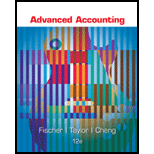
Non-Ordinary Items
They are those items that consist of gains and losses on the company’s income statement which are unusual and infrequent in nature.
The tax expense or benefit to the two non-ordinary items.
Answer to Problem 12.4P
Net Tax expenses for value E is
Explanation of Solution
| Particulars | Amount in $ |
| YTD income (loss) | |
| Projected income (loss) | |
| Total annual income (loss) | |
| Carry forward of 2013 loss | |
| Estimated annual taxable income | |
| Estimated tax: | |
| On first | |
| On next | |
| On next | |
| Remaining income | - |
| Less: Tax credit | |
| Net tax | |
| Effective Rate | |
| Tax expense |
Calculation of tax expense:
Effective interest rate
Calculation of tax expense :
Tax expense =Quarter 1 -restated continuing income × effective tax rate
Item C
Tax expense originally reported for quarter 1
| Particulars | Amount in $ |
| Tax expense (benefit) traceable to restated: | |
| Continuing operations | |
| Discontinued operations | |
| Tax expense originally reported for quarter 1 |
Item D
Tax expense for quarter 2 income from continuing operations:
| Particulars | Amount in $ |
| Quarter 1 — restated income (loss) | |
| Quarter 2 — income (loss) | |
| YTD income (loss) | |
| Projected income (loss) | |
| Total annual income (loss) | |
| Carry forward of 2013 loss | |
| Estimated annual taxable income | |
| Estimated tax: | |
| On first | |
| On next | |
| On next | |
| Remaining income | - |
| Less: Tax credit | |
| Net tax | |
| Effective tax rate | |
| Tax expense |
Calculation of effective tax rate:
Effective interest rate
Calculation of tax expense:
Tax expense
= Quarter l -restated continuing income x Effective tax rate
Item E
| Particulars | Amount in $ |
| Quarter 1 - restated | |
| Quarter 2: | |
| Operating loss | |
| Realized loss on disposal | |
| Impairment loss | |
| Value of E |
ITEM F
| Particulars | Ordinary income | Total income | Total excluding Non- ordinary loss | Total excluding Non-ordinary gain | |
| Pretax income (loss): | |||||
| Continuing | |||||
| Discontinued | _ | - | |||
| Extraordinary | _ | - | |||
| Pretax income | |||||
| (loss) | |||||
| Tax expense | |||||
| (benefit) | |||||
| Taxable income: | |||||
| Pretax income | |||||
| (loss) 2013 loss | |||||
| Taxable income | |||||
| Estimated tax: On first On next On next Remaining income Less: Tax credit | |||||
| - | |||||
| Net tax | - |
Incremental tax expense (benefit)
| PARTICULARS | AMOUNT IN $ |
| Incremental tax expense (benefit) traceable to: | |
| All non-ordinary items | |
| All non-ordinary losses |
CONCLUSION Net Tax expenses for value E is
Want to see more full solutions like this?
Chapter 12 Solutions
Advanced Accounting
- Sheinberg Industries reported 2023 sales ($ in millions) of $6,842 and a cost of goods sold of $5,120. The company uses the LIFO method for inventory valuation. It discloses that if the FIFO inventory valuation method had been used, inventories would have been $89.6 million and $73.2 million higher in 2023 and 2022, respectively. If Sheinberg used the FIFO method exclusively, it would have reported 2023 gross profit closest to? a. $1,110.5 million b. $1,319.1 million c. $1,738.4 million MCQarrow_forwardPlease provide the correct answer to this financial accounting problem using accurate calculations.arrow_forwardHonda Corporation had beginning raw materials inventory of $34,500. During the period, the company purchased $128,000 of raw materials on account. If the ending balance in raw materials was $22,700, the amount of raw materials transferred to work in process inventory is?arrow_forward


